As more organizations start an Oracle Cloud Infrastructure Cloud journey, the importance of optimizing operational efficiency becomes paramount. This blog explores developing predictive insights on workload resource usage trends and capacity planning using Operations Insights. We investigate the resource utilization and performance metrics of the Exadata infrastructure including the Exadata Cloud Service and Exadata Cloud@Customer deployments.
Capacity planning involves forecasting future resource needs and scaling infrastructure accordingly to avoid performance or availability issues and ensure adequate capacity is available for growth. By implementing these strategies, organizations maximize the performance of all Exadata deployment solutions, resulting in improved uptime, faster performance, and efficient resource utilization.
Capacity Planning and Workload management strategies maximize Exadata deployments
Both Operations Insights Exadata Insights and Exadata Warehouse are integrated with Oracle Enterprise Manager (EM) and offer a streamlined approach to enhancing the operational efficiency of Exadata systems. This is accomplished via analysis of the Oracle EM repository and Exadata Management Server metrics data. By leveraging these OCI features, organizations gain valuable insights into their Exadata infrastructure, enabling better resource capacity planning, workload forecasting, and optimal resource allocation.
- Exadata Capacity Planning using OCI Operations Insights Exadata Insights
- Exadata workload forecast and analysis using Exadata Warehouse
Operations Insights and Enterprise Manager integration
Operations Insights is an OCI-native service that provides holistic insight into the database and host resource utilization and capacity. Operations Insights consists of the following integrated applications, check out the details about each feature here.
- Capacity Planning (database and host)
- ADDM Spotlight
- Exadata Insights
- Exadata Warehouse
- Oracle SQL Warehouse
- EM Warehouse
- AWR Hub
- Data Object Explorers (SQL, Exadata, etc.)
- Dashboards
Extending Enterprise Manager into Cloud Bridge
- An EM side Cloud Bridge is set up which moves target-level data from EM and Exadata target-level Real-Time Insight metrics data to the OCI Object Storage bucket.
- Cloud Bridge is then coupled with an Operations Insights side EM Bridge, which moves data from the OCI Object Storage bucket to Operations Insights’ data store for analytics utilizing Exadata Insights features.
- For Exadata Warehouse, Cloud Bridge is configured to push data into OCI Object Storage. The data is then loaded and transformed into a stand-alone Autonomous Data Warehouse.
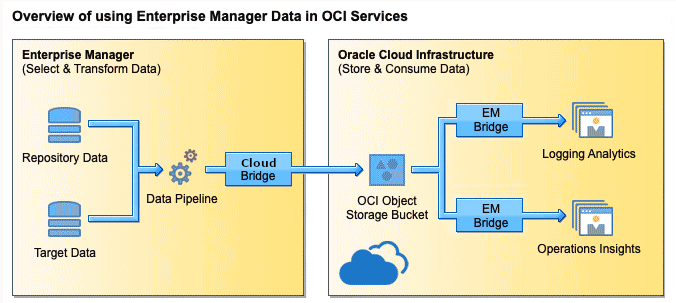
Predictive Exadata Insights help analyze resource utilization
Exadata Insights helps analyze the resource utilization of the Exadata systems and identify the spare capacity for new workloads. This feature is available for Exadata systems that are managed by Oracle EM 13.5 RU05 and later.
A single integrated view of all Exadata systems across an enterprise helps identify issues and troubleshoot them quickly. You can view the categorization of the Exadata deployments based on the fleet type, rack type, the systems with low or high resource utilization, and the global resource usage in terms of CPU, memory, I/O, and storage. Furthermore, you can drill down from infrastructure to the database level by leveraging Oracle SQL Warehouse within Operations Insights to gain insights on SQL performance impacts on the Exadata system. Exadata Insights integrates with OCI-native features like tagging, alarms, events, IAM policy enforcement, etc. thereby enabling users to manage resources effectively across the enterprise.
Exadata Warehouse intelligent analytics for cloud and on-premises
Exadata Warehouse provides a store-based custom analytics solution that helps maximize the performance and utilization of critical workloads running on all Exadata and ZDLRA deployments that are monitored by EM 13.5 RU10 or later. Exadata Warehouse functions as a long-term storage repository for fine-grained performance and resource utilization metrics.
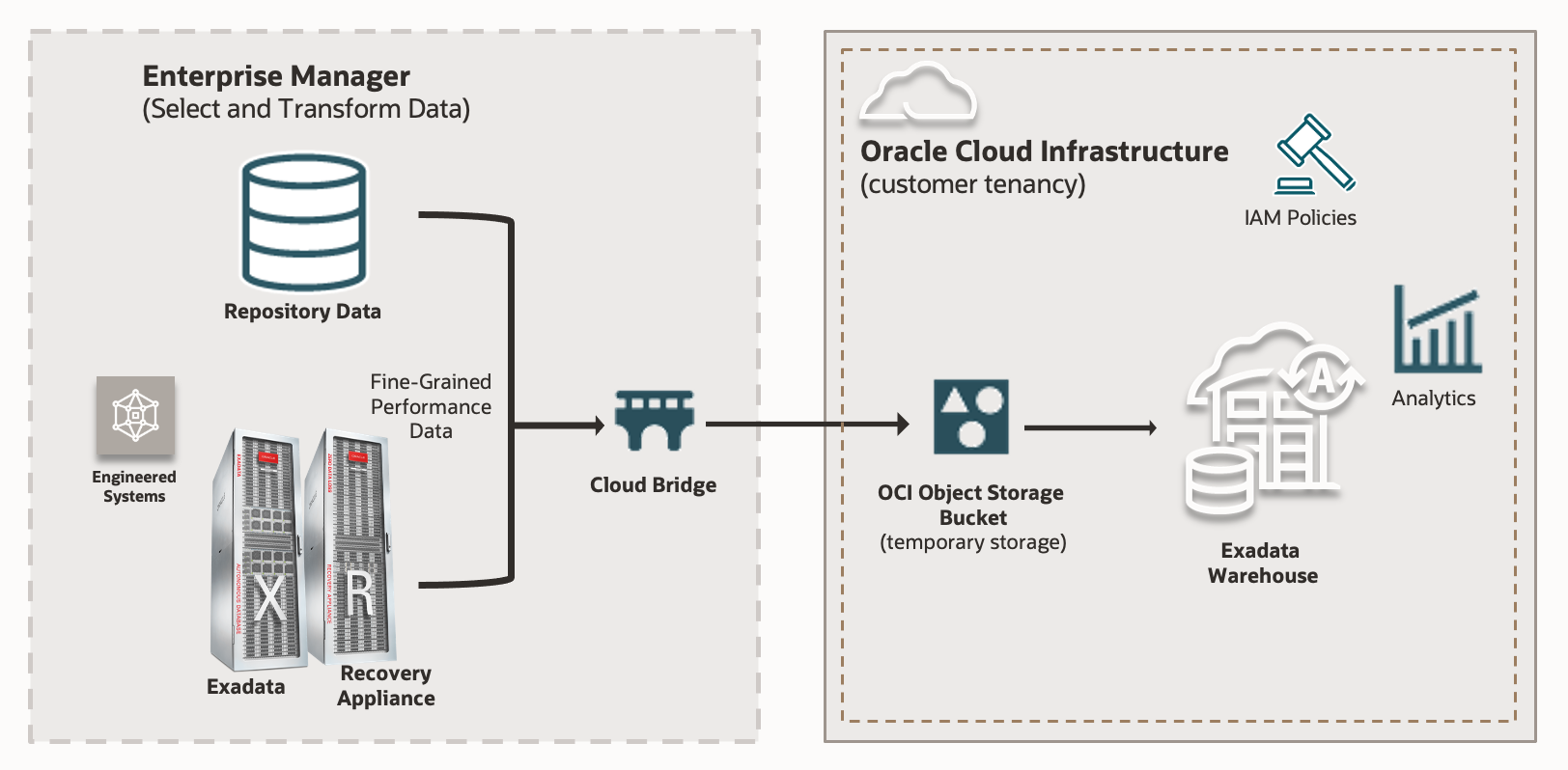
Key differences between Exadata Insights and Exadata Warehouse
| Category |
Exadata Insights |
Exadata Warehouse |
| Data Source |
Uses the EM repository data for capacity planning and workload forecast Note: EM as a Data source is not a requirement for Oracle Exadata Database Service on Dedicated Infrastructure (ExaDB-D); one can simply configure a Private Endpoint in Operations Insights to communicate with the Oracle Cloud Database |
Uses the EM repository data and Exadata Management Server metrics data (Real-Time Insight metrics data from Exadata compute node and Exadata Storage Server) for capacity planning and trend and forecast analysis |
| Metric data collection interval |
15 mins (Depends on the EM collection frequency) |
1 min |
| Retention Policy |
Rolled-up data (Hourly and Daily): 25 months |
|
| Data Flow |
Out-of-box dashboard visualization is available via Exadata Explorer, along with native integration with OPSI Dashboards | Data from EM Cloud Bridge is loaded into and transformed within a stand-alone Autonomous Data Warehouse |
| Visualization Solutions |
Out-of-box dashboard visualization is available via Exadata Explorer, along with native integration with OPSI Dashboards |
Complementary Do-it-yourself (DIY) visualization solutions such as Oracle Analytics Cloud and Oracle APEX are available to present the data in the warehouse |
| Machine Learning | Native ML-based forecasting options
|
Out-of-the-box integrated ML-based forecasting using a proprietary algorithm with seasonality awareness. For any other ML algorithms beyond out-f-the-box support, customers use a DIY approach |
Key use cases for Exadata Insights and Exadata Warehouse
For more details, check the documentation Exadata Monitoring Real-Time Insight.
| Exadata Insights | Exadata Warehouse |
|---|---|
|
|
|
|
|
|
Overview configuration of Operations Insights Exadata Insights and Exadata Warehouse
Prerequisite: EM Side – Exadata Infrastructure is discovered within EM. For more details, check the documentation to discover Exadata Cloud Targets.
Set up Cloud Bridge and EM Bridge
- OCI Side: Ensure an OCI Object Storage Bucket has already been created
- EM Side:
- Step 1: Define a Global Named Credential in EM for OCI
- Step 2: Define Host Preferred Credentials for all Database Machine Monitoring Agent hosts and OMS host
- Step 3: Set up an exclusive EM Super Administrator user for the Enterprise Manager login
- Step 4: Create an EM group containing the targets for the data exported
- OCI Side: Set up the requisite OCI Policies needed for EM to push data into Object Storage Bucket
- EM Side: Configure the Cloud Bridge to export EM target data into OCI Object Storage Bucket
- OCI Side: Configure EM Bridge to ingest EM target from Object Storage Bucket to Operations Insights Service for processing
For more details, check the documentation Integrate Enterprise Manager with OCI Services.
Configure Exadata Insights
- OCI Side:
- Step 1: Configure the Exadata Fleet in the Operations Insights Administration
- Step 2: Add the Exadata system to Operations Insights using the EM Bridge configured in early steps
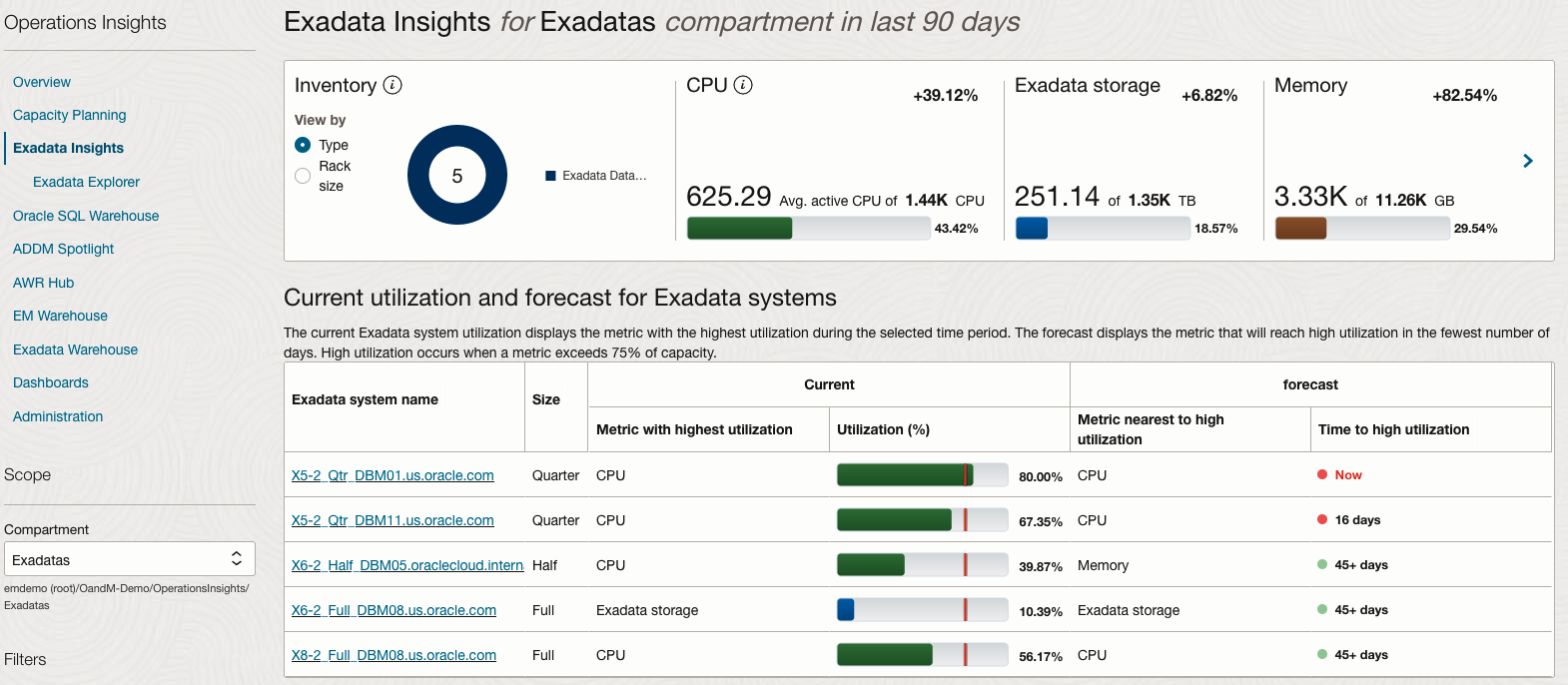
For complete details, see Configuration of Exadata Insights.
Perform custom analysis using Exadata Explorer and Dashboards
Exadata Insights Exadata Explorer is a powerful and easy-to-use interface to explore the Exadata metrics and performance indicators. Queries that have been created in Exadata Explorer and can now be saved for viewing at a later point in time, shared among colleagues, and also placed directly onto a dashboard alongside other “widgets.” Additionally, various visualizations such as lines, bars, areas, and pie charts are available in the Exadata Dashboards.
Access Exadata Explorer under Exadata Insights:
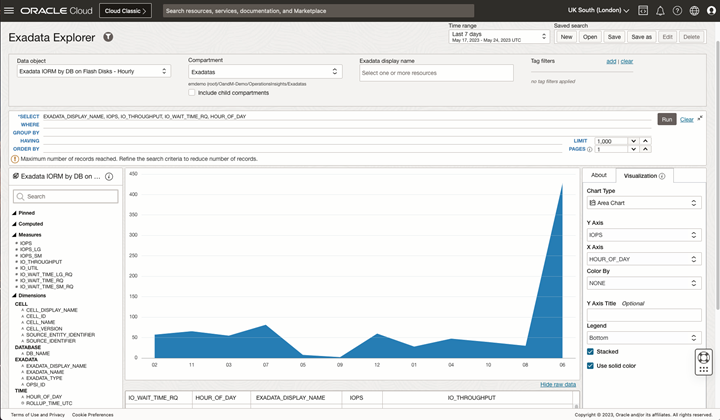
Configure Exadata Warehouse
In summary, this configuration is as follows:
- OCI Side: Provision Autonomous Data Warehouse (ADW) and create an Analytics User to hold the Analytics Schema.
- EM Side:
- Step 1: Discover the ADW on EM.
- Step 2: If using CellCli to get metric data from the database machine storage servers, switch to using REST API.
- OCI Side:
- Step 1: Kick off the Data Export
- Step 2: Verify the Exadata Warehouse data in the ADW database
For more details, check the documentation Export and Analyze Oracle EM Engineered Systems Performance Data Using Exadata Warehouse.
Configure Analytics Cloud
Use Oracle Analytics Cloud for data visualization. In summary, this configuration is as follows:
- OCI Side:
- Step 1: Create Oracle Analytics Cloud instance
- Step 2: Configure an ADW database connection and data sources
- Step 3: Visualize the Exadata Warehouse Forecast data via Oracle Analytics Cloud
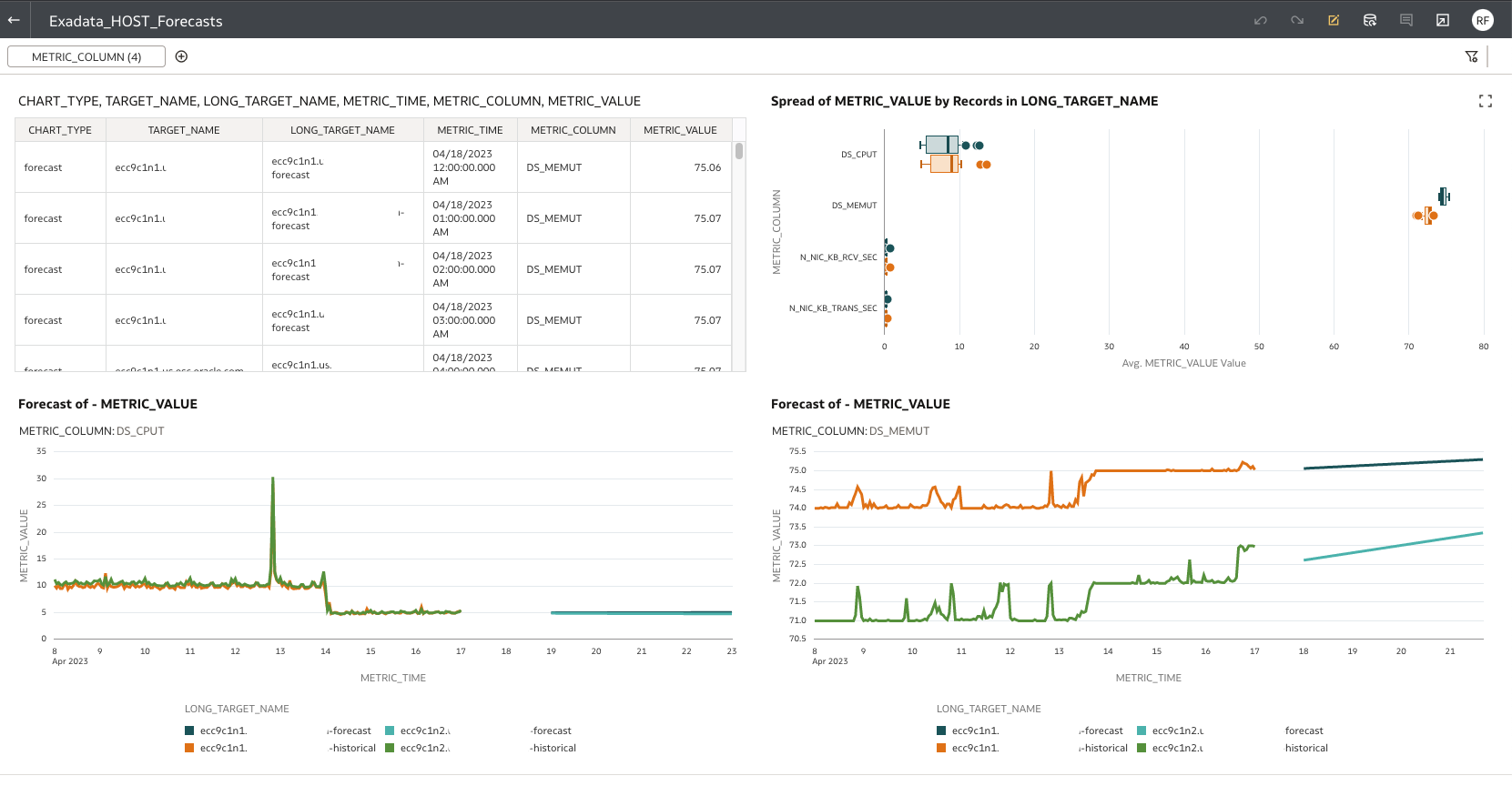
For complete details see Oracle Analytics Cloud.
Conclusion
Operations Insights Exadata Insights and Exadata Warehouse solutions integrated with EM offer a streamlined approach to enhancing the operational efficiency of Exadata systems via data analysis of EM repository data and Exadata Management Server metrics data. By leveraging these Operations Insights service features, organizations can gain valuable insights into their Exadata infrastructure, enabling better resource capacity planning and workload forecast and allocation.
Both Exadata Insights and Exadata Warehouse provide predictive insights of Exadata infrastructure for Exadata customers to focus on metrics and key performance indicators for obtaining actionable insights to facilitate informed decision-making, thus achieving the business and organization resource management objectives.
Choosing Exadata Insights or Exadata Warehouse based on requirements and considerations
| Solutions/Criteria | Time to Value | Out of Box vs Custom | Expertise | Cost |
| Exadata Insights | Fast: Customers get the value as soon as the uploaded data is available for analysis, typically in a few days |
Medium: Limited access to raw data by utilizing out-of-box and dashboard visualization tools | None | No incremental cost on top of Operations Insights SKU |
| Exadata Warehouse | Moderate Additional time is needed to set up ADW and visualize data |
High
|
Basic understanding of metric data and data science additional | Additional cost for the analytical store (ADW) and visualization tools on top of Operations insights SKU |
Sign up for an Oracle Cloud Infrastructure free trial account today to try out new Oracle Cloud Infrastructure features!
Contributors: Swapnil Sinvhal, Elizabeth Li, Chris Gurley, Girish Balachandran, Murtaza Husain
Resources:
Exadata Insights in OCI Operations Insights
Integrating Enterprise Manager 13.5 with OCI Services
Discover Operations Insights for Exadata Database Service with new filtering and thresholds option

